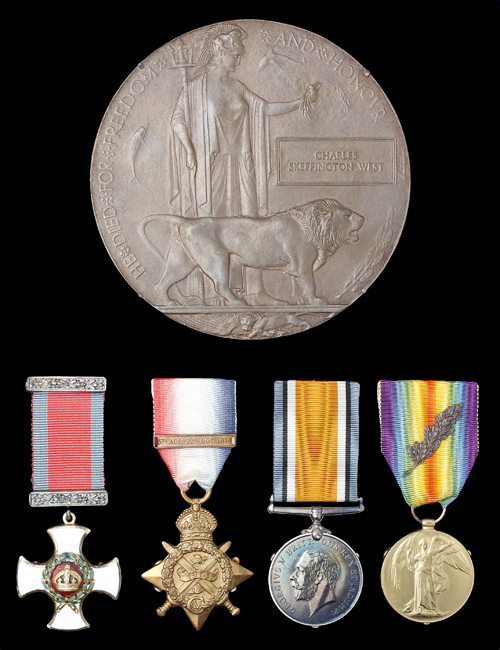
Auction: 1008 - Orders, Decorations, Campaign Medals & Militaria
Lot: 8
A Scarce 1917 Naval Division D.S.O. Group of Four to Commander C.S. West, Who Was Engaged In, and Escaped From, the Defence of Antwerp; Served as Second in Command of Collingwood Battalion, Before Being Wounded During the Third Battle of Krithia, Gallipoli, 4.6.1915, When the Battalion Was Virtually Wiped Out; He Returned to Action With Howe Battalion On The Western Front, Commanding Them From May 1917, Before Being Killed in Action on Welsh Ridge, 30.12.1917 a) Distinguished Service Order, G.V.R., silver-gilt and enamel, with integral top riband bar b) 1914 Star, with Bar (Lieut. C.S. West, R.N.V.R. Hawke Btn. R.N.D.) c) British War and Victory Medals, M.I.D. Oakleaves (Commr. C.S. West. R.N.V.R.), extremely fine, with Great War Bronze Memorial Plaque ´Charles Skeffington West´, all housed in a glazed and hinged wooden display case, with M.I.D. Certificate, dated 9.4.1917, in original envelope addressed to ´Mrs. West, Staverton, Wokingham, Berks.´ (4) Estimate £ 4,500-5,500 D.S.O. London Gazette 17.4.1917 T/Lt.-Com. Charles Skeffington West, R.N.V.R. ´For conspicuous gallantry and devotion to duty. He rendered invaluable service by most ably guiding and placing companies of the battalion in their battle positions within 400 yards of the enemy. He worked continuously under heavy hostile shell-fire, and was largely responsible for the success of the operations.´ Commander Charles Skeffington West, D.S.O. (1886-1917), born at Temple Michael Rectory, Longford, Ireland; the son of the Reverend H.M. West and 1st cousin of Lieutenant-Colonel Richard Annesley West, V.C., D.S.O., M.C.; educated at St. Clare, Walmer, and H.M.S. Britannia; Commissioned Midshipman, Royal Navy, 15.5.1902; served in the Channel Squadron, 1902-1903; served in the China Squadron, 1903-1905; Acting Sub-Lieutenant 15.7.1905; was invalided from 1905 on his return from China until 1908; entered Trinity College, Cambridge, 1911, taking a 2nd Class in the History Tripos; immediately volunteered for service at the outbreak of the Great War and was gazetted Lieutenant, Royal Naval Volunteer Reserve, 25.8.1914; he was promoted Lieutenant-Commander and went with Hawke Battalion Royal Naval Division as part of the 1st R.N. Brigade to Dunkirk 5.10.1914; from here he was engaged in the Defence of Antwerp, 4-10.10.1914; poorly equipped and fighting a withdrawal West was one of approximately 1,500 men who crossed the Dutch Frontier to escape Antwerp; he was interned in Holland before ´he, with two others, succeeded in escaping in disguise, thus avoiding having to give parole, May 1915´ (The Distinguished Service Order 1886-1923, refers). Gallipoli and the Ill-Fated Collingwood Battalion Having managed to return to the UK West was posted to Gallipoli as Second-in-Command of the Collingwood Battalion and landed on the Peninsula 28/29th May 1915; the Collingwood joined the Howe, Hood and Anson Battalions in the 2nd R.N. Brigade; West´s battalion arrived in time to participate in the Third Allied attack on Krithia, which was to be a direct frontal assault on the whole of the Turkish forward position; on the 4th June the British attack was to be carried out by the 29th, 42nd and Naval Divisions, each attacking the Turkish trenches opposite their own...... At 12 noon the [R.N.D.] assaulting force had consisted roughly (excluding details left in the transport lines, at the Field Ambulances or at rest camp) of 1,900 men and 70 officers ...... Now at 12.45, there returned to our lines 5 officers and 950 men´ (The Royal Naval Division, D. Jerrold refers); West who had commanded the men of Collingwood held in Brigade reserve was wounded during the action; the losses had been so severe that the men of Benbow and Collingwood (both newly arrived at the front) were absorbed into the Hood, Howe and Anson Battalions; after three weeks of recuperation in Alexandria West returned to Gallipoli as Second-in-Command of the Howe Battalion, a position which he was to hold until the R.N.D.´s evacuation from Gallipoli, January 1916. Howe Battalion - The Western Front West went with the battalion to France, May 1916 and moved on to the Somme Front at the beginning of October in anticipation of being involved in a renewed offensive; final orders, for what was to be the Battle of Ancre, were received on the 10th November, ´the plan, as finally adopted, was for an attack on Serre, Beaumont Hamel, Beaucourt and St. Pierre Divion by the 2nd Division of the XIIIth Corps, the 3rd, 51st and Naval Divisions of the Vth Corps and the 31st Division of the IInd Corps. The Naval Division´s sector (1,200 yards in width) was immediately north of the Ancre, at right angles to the river valley, which ran here almost due east to Beaucourt, while our trenches and those of the enemy ran roughly north and south. The Division´s objective was Beaucourt and the intervening positions opposite to their front.´ (ibid); on the morning of the 13th West´s Howe Battalion, as a part of a combined force, advanced behind the creeping barrage of the attack and successfully pressed home their objectives (including the German front line system); the R.N.D. secured Beaucourt the following day, during this action which was to be the final act of the 1916 Battle of the Somme, Lieutenant-Colonel B. Freyberg (Officer Commanding Hood Battalion) won his Victoria Cross; Howe Battalion suffered heavy losses marching out from the battle with less than 100 men; after the Battle of Ancre the Naval Division was withdrawn from the battle area for two months´ rest; West returned to the same front in January 1917, still as part of the 188th Brigade, to find that British lines had been pushed forward some distance beyond Beaucourt, but were still below the crest of the ridge which commanded Grandcourt; with the capture of the latter West´s battalion moved into Grandcourt, 6.2.1917; they were in action again, spearheading the Naval Division´s part of the attack on Miraumont, 17-18.2.1917, ´the attack was brilliantly successful, and in the case of the Howe Battalion (on their right) the casualties were extremely light....... On the morning of February 18th, a counter-attack developed, but it was annihilated before it reached our lines by the extremely effective barrage of the divisional artillery and the 188th and 190th Machine-Gun Companies. On the night of the 21st-22nd, the 188th Brigade handed over to the 190th the new position consolidated and intact´; the 1st Royal Marines, who had partnered West´s battalion in the attack, had suffered over 400 casualties, whereas Howe had suffered 2 officers and 20 men killed; at the end of February the Naval Division was relieved from duty in the line, with West´s men in action again during the Spring Offensive of 1917; at the end of March the Naval Division reached the front north of Arras and then were engaged during the first Battle of Gavrelle, April 1917; involved in almost continuous fighting between 15th April-29th April, the Naval Division suffered total battle casualties of 170 officers and 3,624 other ranks, of whom upwards of 40 officers and 1,000 other ranks were killed. Commanding Officer at Last Much re-organization was required after the battle, including ´Commander Ramsay Fairfax, C.M.G., D.S.O., R.N., Commanding the Howe Battalion, was invalided during May and was succeeded by Commander C.S. West, D.S.O., R.N.V.R., who had gone out to Gallipoli as second in command of the unfortunate Collingwood Battalion´ (The Royal Naval Division, D. Jerrold, refers); waiting for the delayed Flanders Offensive to begin the Naval Division were tasked to carry out a number of minor operations to keep the enemy in expectation of continued attacks to come from their front, ´the Division had become familiar with these tactics in Gallipoli and it often meant establishing posts and consolidating sapheads in front of the line and then digging by night, ´on the night of July 14th-15th a new front line was dug in Oppy Wood by the Hawke and Hood Battalions and in front of the Windmill by the 2nd R.M. Battalion, while on July 20th a very successful raid was carried out on Gavrelle Trench by the Howe Battalion. The raid was carefully planned and rehearsed under the supervision of Commander C.S. West, and commanded by Lieutenant W. Marlow, R.N.V.R. Only in one place did the enemy put up a vigorous resistance, and our reported losses (7 men killed and 1 officer and 25 men wounded) were sustained mostly before and after the operation. The enemy losses in killed and prisoners alone exceeded our total casualties. The raid had found the enemy generally listless and ill-prepared. Their trenches were ill-constructed and badly tended, while many of the garrison were caught without arms or equipment´; at the end of September the Naval Division was drafted in to participate in the much delayed Flanders Offensive, the objective of which at the time was the Passchendaele ridge; West´s battalion as part of the 188th Brigade carried out an attack towards Poelcappelle, as part of the 2nd Battle of Passchendaele, 26.10.1917; in terrible mud and with awful communications the 188th Brigade carried at least five strongly fortified enemy posts and an advance of 300 to 400 yards from the old front; Sir Hubert Gough said, ´no troops could have had to face worse conditions´; 5 officers of the Howe Battalion were killed and ´the losses in N.C.O.´s and men were equally severe, averaging more than 500 a battalion in the 188th Brigade´; the Naval Division were relieved from the front line , 6.11.1917; on the 6th December the Division entrained for the Cambrai front; on arrival they moved into positions on Welsh Ridge, and were tasked with fortifying them, 15th-20th December; they were still holding the positions when, on 30.12.1917, the Germans launched a counter attack against the whole front and, ´on the Howe front, through no fault of the men on the spot, the situation was more serious. Simultaneously with the loss of the front line, a shell falling outside Battalion HQ had killed, Commander West and Lieutenant-Commander Alan Campbell..... The deaths, moreover, of Commander West, of Patrick Shaw Stewart and of Alan Campbell, were in the nature of a grievous personal loss to innumerable officers and men of the Division. They had all served with the Division in the earliest Gallipoli days, and had each contributed much to its reputation, not only as a fighting organization but as the gathering place of so many men who were at once remarkably good company and of brilliant attainments.... Commander West and Alan Campbell were killed by a shell falling at the entrance of their headquarters as they too were moving up to their front line´ (The Royal Naval Division, D. Jerrold, refers). Commander West is buried in the Metz-en-Couture Communal Cemetery, British Extension.
Sold for
£7,500




